This site uses only a few technical cookies necessary for its operation. By continuing to browse, you accept their use.
To find out more...
To find out more...
Circles vs. moulds tins
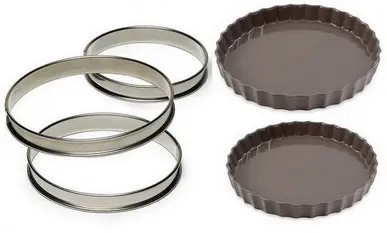
If you like to bake or make quiches, pies etc. you must surely have one or more pie pans at home, in different diameters and perhaps materials.
They are indispensable, without them there is no way to make beautiful pies, and they work very well, but you have another option, instead of moulds, that is pie rings.
They are indispensable, without them there is no way to make beautiful pies, and they work very well, but you have another option, instead of moulds, that is pie rings.
14 K 5/5 (15 reviews)
Keywords for this post:PiesTartsCircleMouldsTipsLast modified on: October 2nd 2020
Circles vs. moulds tins
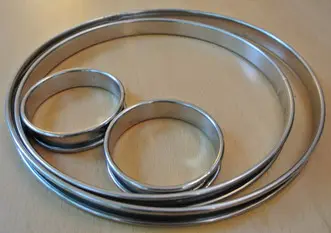
As their name indicates, the circles are simple circles, made of stainless steel, which exist in different diameters, but unlike a mould, a circle has no bottom (yes, this is not an extraordinary statement) so it must be placed on a baking sheet, protected by a sheet of baking paper, or silicone (silpat), before baking.
Before continuing, just 2 words of baker's vocabulary :
-"rolled-out pastry": Piece of dough that is rolled out and used to line a mould/circle
-"line (with pastry)": Action of lining a mould/circle with an abaisse
So on one side we have the classic pie tin, which you put in the oven directly or on a baking sheet, and on the other side the circle, which must be placed on a baking sheet.
Which is better?
The circle has many advantages:- The baking is better, more regular and faster because of the absence of a bottom, more direct contact of the pastry with the heat
- Unmoulding is very easy, you just have to remove the circle from the top and then slide the tart into its serving dish (breaking a tart when taking it out of its mould is a very very frustrating moment!)
- It is very easy to clean, dishwasher safe
- If you go for it carefully, you'll get very elegant and professional right-angled pie edges
- It costs less than a mould
As you can see, it's almost all advantages, that's why pro pastry chefs all use circles, and you can do the same at home.

There is only one case, where the mould is preferable, and that is if you are making a quiche, or a tart with a lot of cooking juice, like a tomato tart, or a fresh plum or blackberry tart for example, in these cases having a mould (rather than a circle) that will retain the cooking juice even if you have a leak in your pastry case is very appreciable.
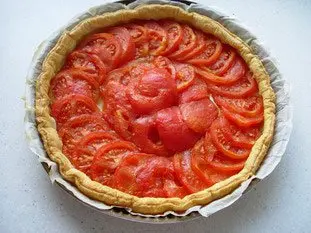
I didn't go into detail, but as for the moulds, there are circles for tarts, of all sizes in fact, and square or rectangular shapes, the pastry cooks speak then rather of "frames".
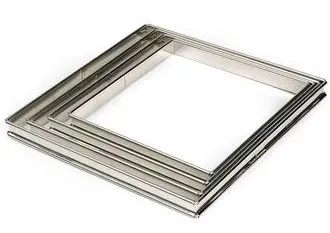
Another quite recent option, the circles are said to be micro-perforated, i.e. pierced with hundreds of small holes that improve the baking process by distributing the heat better.
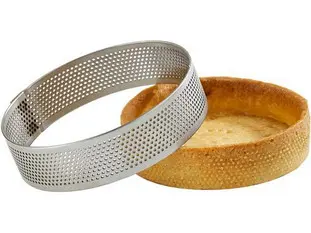
As always for the material, do not hesitate to put the price, it is an investment on the duration, and to go to provide you in the stores for professionals rather than in the ray kitchen of the great surfaces.
To sum up: Try the circles instead of the pie tins, once you get the hang of it, you will appreciate the difference.
Lasts posts
Thinning out herbs
If you need to add a long-stemmed herb (tarragon, mint, verbena, thyme, etc.) to a recipe, you'll probably only need the leaves and not the stem, so you'll need to remove the leaves. Leaf removal means keeping only the beautiful leaves, and eliminating the ugly stems and leaves, but how do you do...August 8th 20257675
Add a bay leaf
Bay leaf: small in size, but big in flavor. You'll find it in hundreds of recipes, and it's often added to cooking meat, in a sauce or broth, usually accompanied by other herbs or products. It's a staple of Provençal, Mediterranean and Oriental cuisine, but not the only one. Usually, in a...July 31th 20251,1715
Parsley stems
Parsley, whether curly or flat, is a delicious ingredient in many recipes, where it is used both raw and cooked. When used raw, in a salad for example, where it always provides, alone or with other herbs, a remarkable freshness, only the leaves are kept. And when used cooked?July 28th 20251,204 13
A drizzle of olive oil
Often in a recipe, you have to "baste" vegetables, for example, before sending them to the oven. What the author means by this is that you need to put oil on top of the vegetables to cook them in the oven. Typically, we just quickly drizzle oil over the vegetables, hoping not to miss any, but...July 13th 20251,4335
Always secure your cutting board
When using a cutting board, it's very important that it's stable and doesn't move while you're cutting, for safety's sake. Boards have a natural tendency to slide on the work surface, but here are 2 ways to block them effectively.July 1st 20251,5125
Other pages you may also like
Butter doesn't make you fat, unless you eat too much of it.
Whenever I'm discussing cooking and recipes, there is one idea which comes up frequently, like this: "Oh no! But that's got butter in it" (I should add, for the sake of accuracy, that this is something I hear more frequently from women, who are almost all concerned with keeping their figure). ...March 26th 201241 K4.5
Steam for baking bread
What does steam have to do with bread-making? This is not only a bakers' secret, it is something you might not think of at all: if you make bread and bake it like a cake, you will end up with bread, but pale and with a thick, hard crust – a long way from the golden-brown crusty loaf you had in...June 16th 2021141 K4.5
85 grams of eggs?
Some time ago, I already spoke to you about the difference between baking and pastry-making, I emphasized, among other things, the precision of pastry-making which requires grams, cm, degrees and minutes. That's why, on the one hand, you have baking and cooking, where a certain tolerance is...November 26th 201852 K4.6
The right weight of pastry for a pie
Let's try to solve a thorny problem: How much dough will I need when I make my next pie? You're planning to make a pie, you're going to use your favourite mould or circle, but how much pastry will you need to fill it completely with a well spread pastry, without being too thin, or on the contrary...March 20th 202064 K4.3
Thermal inertia or "out of the fire"
When you're cooking, you need a lot of heat to cook, and most of the time it's on the fire, literally if you're on gas, more indirectly if you're not. An expression that comes up quite often is "Off the heat", but what does it really mean?December 12th 20207,9684.6
Post a comment or question
Follow this page
If you are interested in this page, you can "follow" it, by entering your email address here. You will then receive a notification immediately each time the page is modified or a new comment is added. Please note that you will need to confirm this following.
Note: We'll never share your e-mail address with anyone else.
Alternatively: you can subscribe to the mailing list of cooling-ez.com , you will receive a e-mail for each new recipe published on the site.









